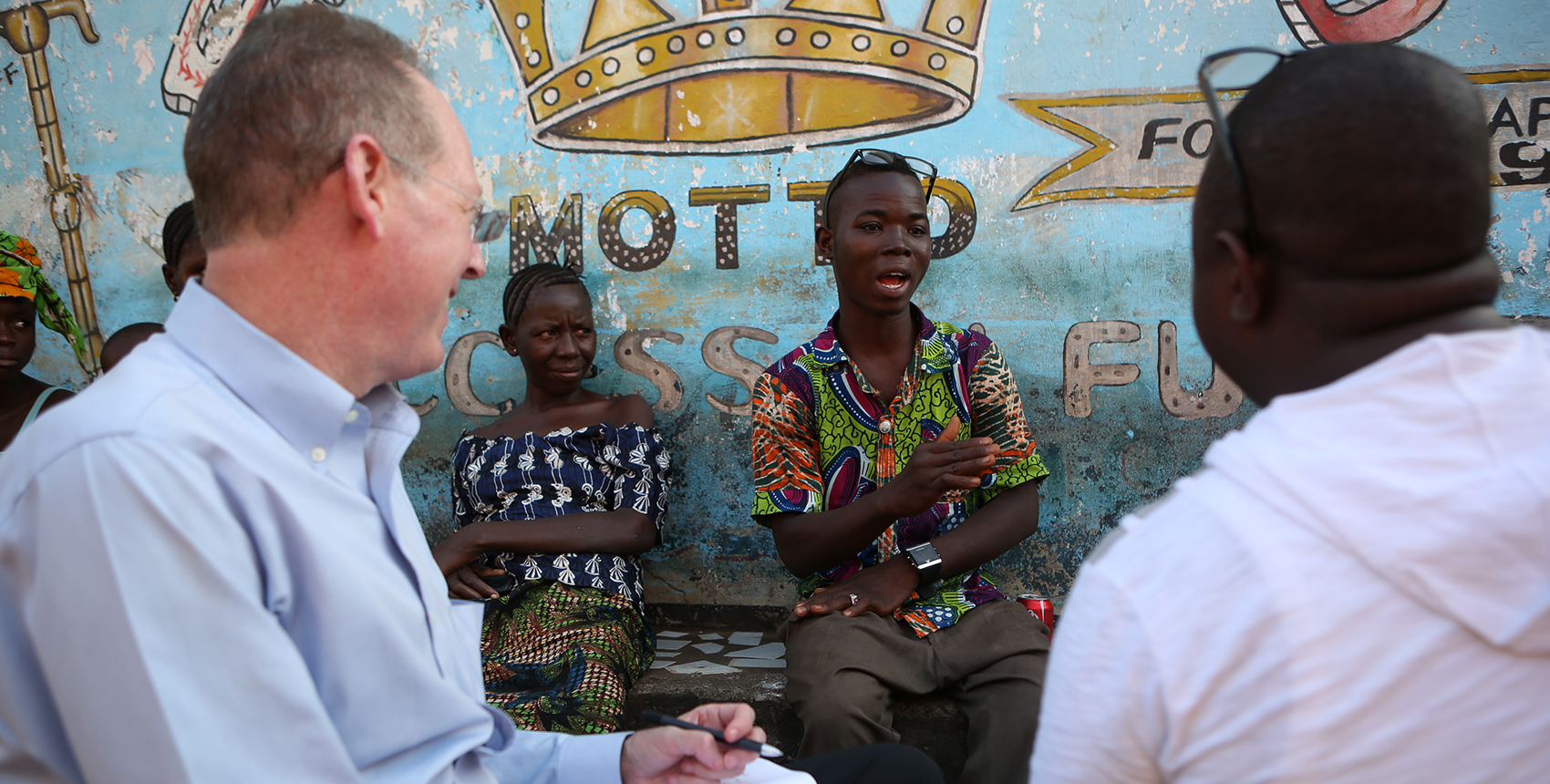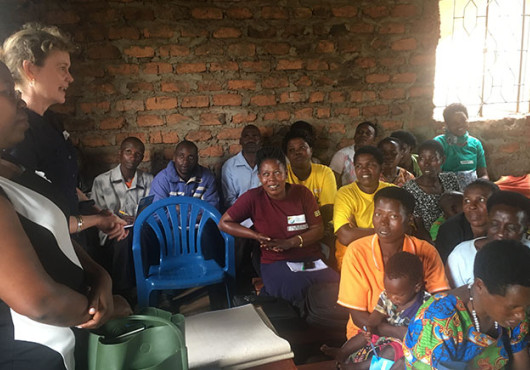
Paul Farmer, chair of the Department of Global Health and Social Medicine in the Blavatnik Institute at Harvard Medical School, was not planning to write a book about Ebola when he went to Sierra Leone in June 2014 for a conference on global access to surgical care.
But as the disease swept through that country, and through neighboring Liberia and Guinea, Farmer bore witness to what would become the largest Ebola epidemic in history.
Farmer’s latest book, Fevers, Feuds, and Diamonds: Ebola and the Ravages of History, shares the stories of those afflicted with the disease and describes the systemic health care failures that allowed the virus to spread and kill with devastating rapidity. At least a third of the book examines the centuries of exploitation that both rendered West Africa a “clinical desert” and rolled out the red carpet for the Ebola virus.
Farmer, who is also co-founder and chief strategist of Partners In Health, chair of the Division of Global Health Equity at Brigham and Women’s Hospital, and the Kolokotrones University Professor at HMS, discussed the book’s key messages, emphasizing the chronic roots of an acute emergency and the lessons the Ebola epidemic provides for the current pandemic of COVID-19 and for the future of global health equity.
Q: What motivated you to write the book?
A: In November 2014, at the height of the Ebola epidemic in Sierra Leone, I met a young man named Ibrahim who had survived Ebola. He was 26 and was working as a motorcycle taxi driver when he fell ill. Upon discharge from the Ebola treatment unit, he wanted to support and accompany others with the disease. On the evening that I met him, he told me that he’d lost more than 20 members of his family to Ebola. I’m an infectious disease doctor and have been dealing with deadly diseases for a long time, but I was speechless. Ibrahim asked me to interview him about his experience, which, even as an anthropologist, I rarely hear. We started the next day. Ibrahim and I became friends, and he started working with us at Partners In Health, which had launched clinical services in Sierra Leone and Liberia that fall.
My job during the epidemic was to take care of Ebola patients and to help find the resources needed to do our job. But I also wanted to learn about the places where we were working, and that was another reason I ultimately wrote the book. You don’t learn about a setting just by living or working in it. You also learn by studying the context of what’s around you, which you might not always see, and by studying its past. As I began learning about West Africa, I asked, ‘How did it become a clinical desert? Was it always a clinical desert? Was it a clinical desert even before the civil war, which ended only a decade before Ebola hit?’ The question of context fascinated me, so I took time to learn about the region’s history.
Q: What key messages do you hope clinicians and researchers might take from the book?
A: Many of the stories we tell ourselves about deadly pathogens are incorrect. We should be skeptical when the towering mortality seen in African outbreaks of Ebola or Marburg is attributed more to the virulence of the pathogen than to the mediocrity of medical care available to the poor. Giving all the credit to the virus is a dubious proposition when we humans have been the architects of such stunning inequalities. And anytime you go from a medical oasis, like Boston, to a medical desert, like upper West Africa, you see very vividly that it’s really the social conditions—the context—that make these pathogens so deadly in the latter but not in the former.
The social conditions exacerbating the toll taken by Ebola were marked by a dangerous absence of what’s described in the book as “supportive and critical care,” which is provided largely by skilled nurses. Nurses, in our step-down units, our intensive care units, our emergency rooms, save many lives that would otherwise be imperiled. A lot of folks think, ‘I don’t do global health,’ or ‘I’m not an infectious disease expert or an epidemiologist.’ But those credentials or experiences are not really what’s called for in the midst of an Ebola epidemic. What’s needed is a concerted effort to improve the quality of clinical care, and to do that effectively, we need skilled nursing. Clinicians therefore have a big role to play in international public health responses, as we again see with COVID-19.
Q: Clinical nihilism and control-over-care are key paradigms you elucidate. Can you explain how those principles shaped the Ebola epidemic and global health more broadly?
A: Clinical nihilism is the idea that providing high-quality care to the destitute sick, just as we’d want if we or our family members fell ill, is too expensive, not cost-effective, not feasible, or not prudent. I’ve been swimming in clinical nihilism for decades: it obstructed our efforts to treat AIDS in Haiti and cancer in Rwanda. The idea doesn’t come from patients themselves or from their family members; it’s usually perpetuated by public health experts who look, and are sometimes trained, a lot like me. Public health responses are often concerned more with controlling the spread of a disease than with providing care to those sickened by it. Through writing this book, I really came to understand that clinical nihilism is a legacy of formal colonial rule and the sanitary policy that emerged during it. If we want to decolonize global health, we can start by irrigating the clinical desert with needed ‘staff, stuff, space, systems, and social support,’ very material and seemingly mundane things.
Q: The dangers of a research-over-care paradigm are also described in your book. Can you speak to how research and clinical care can work in tandem during a crisis, and the dangers of divorcing the two?
A: When I helped co-found Partners In Health over three decades ago, we aimed to do three things: directly serve those shut out of modern medicine, train others to do so, and generate new knowledge about how to do it better. Partners In Health knows that clinical care, training, and research go together.
What I’ve often seen since the 1980s, however, is a myopic belief held by some organizations that ‘we can only do research,’ or ‘we can only do training,’ or ‘we can only do service delivery.’ One of the reasons Ebola claimed the lives of so many patients and caregivers at Kenema Government Hospital in eastern Sierra Leone was that the hospital’s clinical services had been neglected in the decade after the country’s civil war, even as millions of dollars were invested in research, much of it supported by U.S. government agencies and universities.
Good care is always informed by research. Over the course of the epidemic, my colleagues and I conducted a lot of research, on new diagnostic tools, on better clinical protocols, on systems for contact tracing and triage, on the spectrum of clinical manifestations associated with Ebola infection. But our primary focus, and the reason why we were asked to be in West Africa, was to treat patients, so we were quite critical of a model that advanced research without care.
Q: Your book was published in the midst of the COVID-19 pandemic. How can a better understanding of the Ebola epidemic help us understand the present and the future of epidemics?
A: On many scores, the United States has not done well in its response to COVID-19 over the past year. I don’t think clinical nihilism is what we’ve seen at work here. I think our response has instead been stymied by containment nihilism—the idea that it’s too late to stop the spread of the disease, that we just have to wait for the vaccine and in the meantime slog through the pandemic with our overburdened hospitals and intensive care units. But even as more Americans are vaccinated, we shouldn’t allow complacency or give up on nonpharmaceutical interventions like mask wearing, social distancing, rapid testing, and contact tracing, which will help us bring the curve down even faster.
We should also resist containment nihilism to the end, because this concept will come up again. I’m hoping that we will address these problems head-on and ahead of time and put in place social safety nets to protect essential workers and others who remain marginalized. I have some optimism about that, because this is what the current administration is trying to do. But we still have to resist containment nihilism, and we should always resist clinical nihilism, too.
A version of this story originally appeared in Brigham Clinical & Research News.





